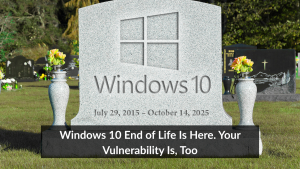
If you're still running Windows 10 in your business operations, we have critical news. The deadline has passed: October 14, 2025, Microsoft has officially ended support for Windows 10. Your systems will no longer receive free security updates, bug fixes, or technical assistance. While your PCs will keep running, they are now sitting ducks for cybercriminals who are actively working to find and exploit vulnerabilities that will never be patched.
This isn't just a hypothetical threat. We saw this exact scenario play out with Windows 7. Shortly after its support ended, the infamous WannaCry ransomware attack exploited a known vulnerability, causing billions of dollars in damages globally to businesses that failed to upgrade. History is repeating itself, and Windows 10 is the new target.
At CKT, we've helped countless clients navigate tech transitions like this without panic. We're not here to sell fear; we're here to arm you with facts, a clear action plan, and our expertise to keep your business secure and compliant. Let's break it down: the risks, your options, and how we can make this upgrade seamless.
The Hidden Dangers of Ignoring Windows 10 EOL
Sticking with an unsupported Windows 10 isn't just outdated; it's a ticking liability bomb for your organization:
- Skyrocketing Security Risks: Without Microsoft's security patches, your devices are prime targets for viruses, ransomware, and zero-day exploits. Cybercriminals know these systems are defenseless. Even top-tier antivirus can't fully compensate for the lack of OS-level protections. A single breach could halt operations, leak client data, and result in massive fines and reputational damage.
- Performance and Compatibility Woes: Expect slower speeds, app glitches, and incompatibility with modern software. Non-subscription Office versions (like 2016 or 2019) also lost support on October 14, amplifying the chaos.
- Compliance Nightmares: Industries like finance, healthcare, and legal face stricter regulations (think GDPR or HIPAA). Running an unsupported OS could trigger audits, penalties, or insurance gaps.
The good news? This risk is 100% manageable—if you act now. Businesses that delay often face rushed, costly migrations later. Don't let that be you.
Your Windows 10 End-of-Life Options, Explained
Now that Windows 10's end-of-life has passed, businesses and individuals must make a decision: upgrade, extend, or switch. Here’s what each option means.
1. Upgrade to Windows 11
Best for: Most modern hardware (check compatibility using Microsoft’s PC Health Check app)
Upgrading to Windows 11 is the natural next step for most users. The upgrade is free for Windows 10 users and delivers stronger built-in security (including Smart App Control), faster performance, and useful new features such as Snap Layouts and Android app support. Plus, it ensures you’ll receive full Microsoft support for years to come.
However, not all devices qualify out of the box. Windows 11 requires TPM 2.0, Secure Boot, and a compatible CPU, and roughly 40% of PCs may not meet these requirements without hardware adjustments.
2. Extended Security Updates (ESU)
Best for: Organizations needing a short-term bridge while planning a full migration
The Extended Security Updates program provides critical security patches for up to three additional years (through 2028 for Microsoft 365 users). Enrollment is simple and can be managed directly through Windows Settings.
That said, ESU does not include new features or full Microsoft support. It’s designed as a temporary solution, and costs increase each year, approximately $61 per device in Year 1, $122 in Year 2, and $244 in Year 3 for businesses.
3. New Hardware Purchase
Best for: Older PCs that can’t upgrade to Windows 11
If your current systems are too outdated to meet Windows 11’s requirements, investing in new hardware might be the smartest long-term option. Most new PCs come with Windows 11 pre-installed, and many vendors, including Dell, HP, and Lenovo, offer trade-in programs that can help offset costs.
The tradeoff is a higher upfront investment, and the need to migrate data and settings to your new device.
4. Alternative Operating Systems
Best for: Budget-conscious users or teams with lightweight computing needs
For some, switching to an alternative OS like Linux Mint or Chrome OS Flex offers a practical, cost-free path forward. These platforms are secure, user-friendly, and well-suited for basic tasks or cloud-based workflows.
The main limitation is software compatibility; certain Windows-only programs may not function properly, making this option less ideal for organizations dependent on specialized Windows applications.
Pro Tip: Back up everything to OneDrive or an external drive before making any changes. Data loss during transitions is the #1 regret we hear. If your hardware doesn't meet Windows 11 specs, consult a professional. Using bypass tools can void warranties and lead to instability.
Why Partner with Common Knowledge Technology? We're Your EOL Experts
As your trusted MSP partner, CKT specializes in stress-free Windows migrations. We've successfully upgraded hundreds of endpoints for clients like yours, minimizing downtime to under 4 hours per device and slashing costs through bulk licensing and hardware audits.
- Free Vulnerability Scan: We'll assess your fleet remotely and deliver a personalized report in 48 hours.
- Custom Migration Plans: From pilot programs to full rollouts, including training and 24/7 support.
- Proven Results: 98% of our clients report zero disruptions during transitions.
Don't gamble with your business's future.


